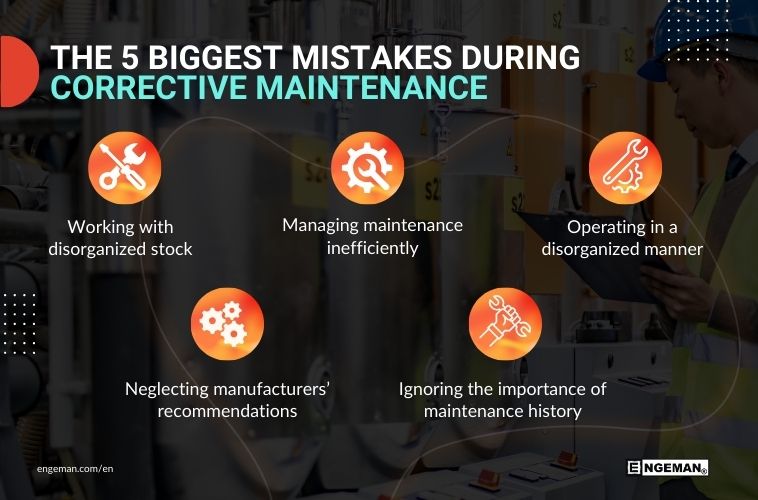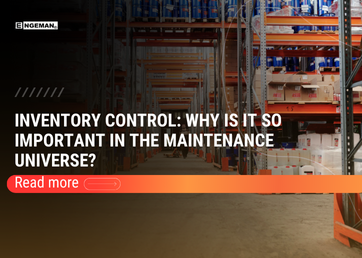Contents
The concept and importance of corrective maintenance
At the moment, we must emphasize the importance of maintenance as a whole, whether preventive, predictive, or corrective. After all, these procedures are directly responsible for the operability and safety of your work environment.
That said, we can focus on corrective maintenance. As the name suggests, this is the procedure performed whenever a piece of equipment performs below expectations. In fact, this is the reason that names maintenance as corrective, being, therefore, the technical intervention to correct an existing problem.
Here, Ronan makes an important comment, because when it is not planned, “this type of maintenance is reactive, reacting to events”. In fact, the lack of planning is one of the worst negligences in the maintenance field, as it directly interferes with the predictability of your operation.
However, this comment also highlights another important point. As it is a reactive procedure, corrective maintenance cannot be anticipated in a calendar with fixed and recommended periods, as in the preventive modality.
For this reason, corrective testing is usually necessary in cases of breakdown or unexpected failures that, most of the time, happen due to the lack of periodic monitoring of the machines.
In this sense, ignoring preventive maintenance ends up increasing the chances of needing corrective ones, because while one tries to prevent the advance of wear, the other corrects a problem that happened due to advanced wear.
At least, both are important for improving your results. But even corrective maintenance can be categorized between planned and unplanned.
Therefore, an unplanned corrective corrects a failure that arises spontaneously and randomly, because of this, it ends up being extremely costly for the operation, generating possible production losses.
Another key point, the planned one, corrects a failure previously identified by predictive maintenance. Because of this predictability, the operation can anticipate how it will deal with the problem, considering process management to perform an intervention that is less harmful to productivity.
The 5 biggest mistakes during corrective maintenance
Now, it is time to learn the main slips during this procedure. As you will see, most mistakes have some connection with negligence or lack of planning, which can be avoided with the help of good maintenance software. See!

1. Operating in a disorganized manner
In general, the lack of planning is harmful to all company departments, especially in the maintenance field. In this area, disorganization can cause many consequences, such as failure to meet deadlines, reduced productivity, a drop in quality standards, and a series of other problems.
Thus, with this in mind, the company’s management needs to have solid planning when highlighting the maintenance team and procedures. Ensuring that the correction is made in the shortest possible time, reducing productive idleness, and accelerating the return to work.
2. Neglecting manufacturers’ recommendations
Here, the infamous practice of ignoring the manufacturers’ guidelines occurs. Among all the mistakes during the corrective period, this is one of the easiest to avoid; just recognize the importance of obeying the recommendations of those who developed the equipment to be repaired.
To avoid this situation, it is very important to have a conscious maintenance team, which is not liable to follow intuition in solving the problem but rather the guidelines and requirements guided by the machine manufacturer.
3. Managing maintenance inefficiently
In a way, this is a mistake that usually complements disorganization. As well as the lack of a clear schedule and logical timeline for solving the problem, poor management aggravates the situation by not being able to coordinate the department transparently.
The result of this is that those in charge do not receive enough information about the condition of the machines due to the lack of communication with the operational department. So, in the absence of predictive maintenance systems, the manager is “in the dark,” not knowing that there is equipment on the line about to break down in the next few days.
In addition, an inefficient command can also extend to the economic field, since cost control is one of the most important things in maintenance management. With the accumulation of negligence, communication noise, and lack of planning, the operation does not comply with preventive procedures and ends up bearing the high costs of unplanned corrective procedures.
Finally, we also highlight the definition of unqualified labor to perform repairs. Moreover, pointing out a vulnerability in the company’s staff, which in this case does not have the necessary skills to perform the procedure quickly and correctly, can also indicate a lack of preparation by management.
4. Ignoring the importance of maintenance history
Moreover, negligence also occurs when disregarding maintenance histories. As you may know, this resource is essential to understanding the operational “health” of equipment in the long term, identifying when and why interventions were performed in the recent past of each machine. To ignore this is to give up an accurate diagnosis and a functional solution.
5. Working with disorganized stock
Finally, the mistake of working with insufficient stocks, in which there are no spare parts available to the team that will perform the repair. The lack of spare parts only serves to increase the idle period, in which both the machine and the operation are paralyzed, costly, and losses.
The solution to these problems
Fortunately, all of these operational failures and planning vulnerabilities can be solved one way only: the use of good maintenance software. It is in this sense that we present Engeman®, our platform with more than 20 years on the market.
Technically, these 2 decades of operation have served to build a tool fully optimized for all operational realities, offering a complete control panel for maintenance routines in the manufacturing, civil engineering, and service provider environments.
Among the features of our platform, we highlight:
- the routine schedule for requesting services, approval and follow-up by the requesters, being able to evaluate the services performed at the end;
- the use of mobile devices with the Engeman® Mobile module, with QR Code reading routines, photo records, electronic signatures, GPS, and the like;
- the planning of activities that will be performed by the maintenance department and monitoring of the services performed;
- the analysis of downtime, production interference, availability, reliability, cost calculation, rates, and failure analysis;
- the management of inputs and labor;
- the leveling of resources with the budget for maintenance, materials, and labor;
- the creation of schedules, Gantt, KPIs, Dashboards, OLAP (Drill-Down) Cubes and Management Charts and much more!
In short, it is a maintenance software that allows for world-class management, as it combines the technical excellence of a team of more than 100 professionals, including engineers, developers, and the like — all to create the perfect tool and support for your day-to-day operations.
Therefore, take advantage of the moment to trace a new route in your operation, avoiding errors during corrective maintenance and other procedures. To do so, just contact our team of experts and learn about our solution!




